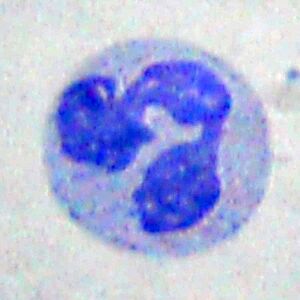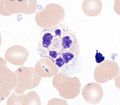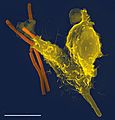Neutrophil facts for kids
Neutrophils are like tiny superhero cells in your blood! They are the most common type of white blood cell. You might also hear them called neutrophil granulocytes. Their main job is to fight off bad guys like bacteria and other tiny invaders, such as fungi, that can make you sick.
When your body gets an infection or an injury, neutrophils rush to the spot very quickly. They have tiny packets inside them called granules. These granules are full of special chemicals called enzymes and peptides. These chemicals help them break down the invaders they catch.
Contents
What Neutrophils Do
Eating Up Germs: Phagocytosis
Neutrophils fight infections by "eating" harmful germs. This special process is called phagocytosis. Imagine a neutrophil as a Pac-Man gobbling up dots! When a neutrophil finds a bacterium, it surrounds and swallows it.
Once the bacteria are inside the neutrophil, they are held in a small bubble called a vacuole. Then, the enzymes from the granules get to work. They chop up and destroy the bacteria, making them harmless.
Part of Your Immune System
Neutrophils are a very important part of your body's immune system. This system is your body's defense team against sickness. Neutrophils are a type of granulocyte, which means they have those special granules inside them.
These busy cells work hard, but they don't live very long. Their life-span is usually only a couple of days. After they've done their job fighting off invaders, new neutrophils are made to take their place.
Images for kids
-
Scanning electron micrograph of a neutrophil (yellow) phagocytosing anthrax bacilli (orange). Scale bar is 5 μm.
-
Neutrophils are seen in a myocardial infarction at approximately 12–24 hours, as seen in this micrograph.
-
In stroke, they are beginning to infiltrate the infarcted brain after 6 to 8 hours.
See also
 In Spanish: Neutrófilo para niños
In Spanish: Neutrófilo para niños









